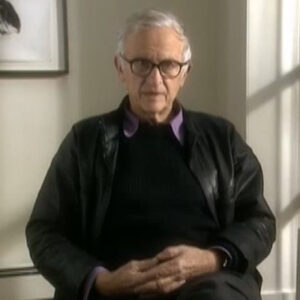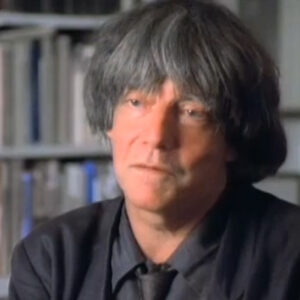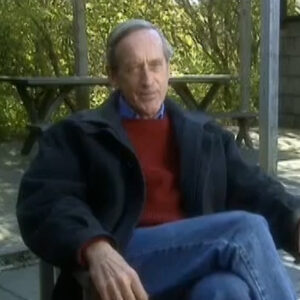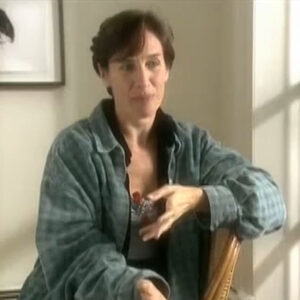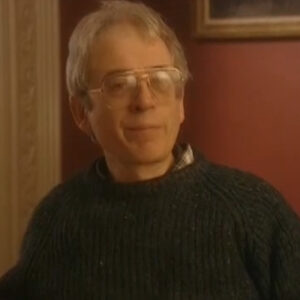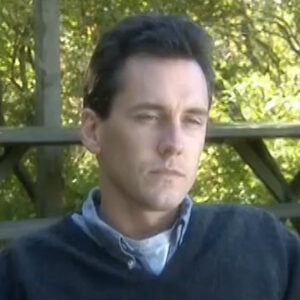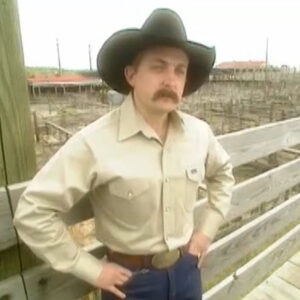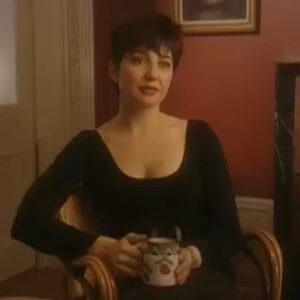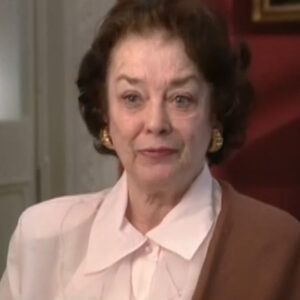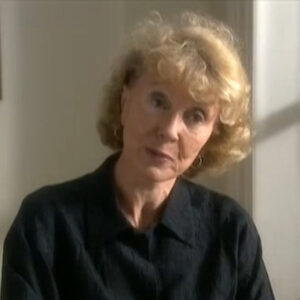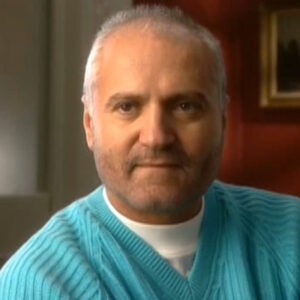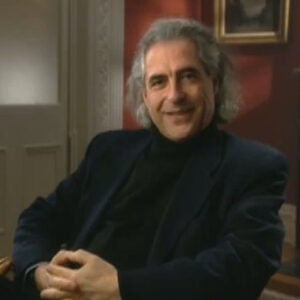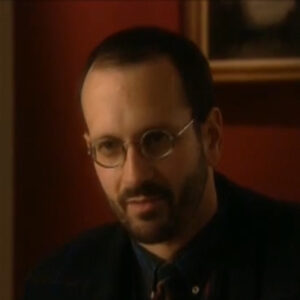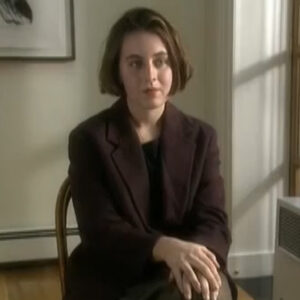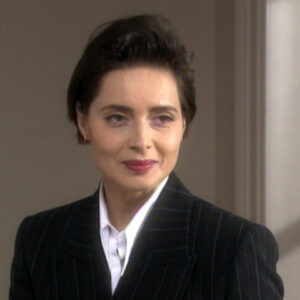Speaker I’m not certain that that is wholly singular. But anyway, one of the things that he very clearly does and I think maybe penned some of it before that, is to change the relationship towards the great who had been at least overtly praised by the camera for all of its history. There are some instances where that’s not the case, but something happens in that post-war world whereby we begin to see, I think, in visual terms before we do in literature, long before what Joyce Carol Oates calls photography, that there are things wrong with the people that we most admire. There is a change stance towards what heroes are and perhaps towards humanity itself with existentialism and whatever after the Second World War. And my guess is that what that is, to some degree, is the outgrowth of what happens in the late 20s and the early 30s with the advent of the 35 millimeter camera, when it becomes so easy to catch people off guard.
Speaker You begin to have people very off guard. You begin to catch them yawning. You begin to catch them cupping their ears. You begin to catch them at awkward moments. Now, in a studio situation, you are putting them into awkward moments and saying this is what is showing you something about this person, that it it’s also the extension of the popularity of Freudian theory, which was much more popular in the United States in the 20s than it was in Europe. The belief that it is the slip that it is the unconscious revealed that is the truth about an individual. And now the studio portrait begins to freeze that for us to see. Now, a lot of it has to do. I I’m sure, an evidence case with his own view of the world, which is not exactly through rose colored glasses, so that he may be the have been the perfect person to do this, being also a very fine photographer. But he and I do think, as I said, that Penn had done it in another way a few years earlier, cornering people and whatever to see what happened and how they responded.
Speaker But he does look at people and say, oh, we’re not necessarily going to look at your apex moment or your peak experience or whatever it is. We’re going to show something that you might not have revealed before. It’s the camera has long been thought, perhaps, to give a sense of truth that you couldn’t get in another way. And then a lot of ways that’s a scam. I mean, in a single picture, how much truth can you get about anybody? Most of us are quite variable.
Speaker Most of us would need an extended portrait to do that. But this was perhaps a shift into what would convey that truth. And I do think he was the one who made that most famous. Let’s say he’s one of crystallizes that in some way. And later on, we took a certain joy in thinking that we were seeing the dirty linens and the dirty soles of the feet. And the awkwardness is of people who we had before preferred to believe were perfect. The change in what the role model is, I suppose, in some way, and I do think, as I said, that I think the visual arts, at least photography does that before writing, which is odd.
Speaker I could ask you this is. I know it’s tough because.
Speaker Well, I think Evernham is one of the people who who earlier than most is saying that celebrity has got its awkward moments, that celebrity has its unpleasant character traits, that celebrity has its faults.
Speaker That celebrities should be shown, warts and all. That celebrity has gotten all that celebrity is gone crazy.
Speaker And it is not a particularly optimistic view of human kind. Certainly. And it is not always ingratiating either. But it does become in many ways the norm after a while. And I do think that those pictures, many of which became iconic, many of evidence, portraits, do point the way to this and do in some respects sum it up right at the beginning of it.
Speaker I do think that happened. I do think that the tacit expectation when you had your photo taken in a studio was that you would be made to look good. The there were some complaint in the 19th century that the politicians that were publishers and British politicians didn’t want their portraits taken because the portraits were too real.
Speaker You know, they were afraid they didn’t look good enough. Certainly when you went to have your wedding portrait taken, you were to be made beautiful. And when you went to Steichen and had a head on a fancy dress and you were mrs. What’s it you were to be made extremely elegant.
Speaker And indeed, if you were a president or a statesman or a businessman, you were to look commanding in some way.
Speaker It didn’t always work. And there has always been an imbalance between the photographer and the portrait subject, which is to say the photographer always has the ultimate advantage. But if he’s being paid by the subject, then he’s got to do something that will play is the subject when the commercial end of it changes, when the paper is not the subject, but is a magazine or whatever, something else may be demanded. That’s one of the things that happens. And then when you become as big a name as evidence does and when celebrity becomes as important as it seems to have become in this country and other countries after the Second World War, you are willing to be shown in some other manner. People after evidence first book was published. Certainly when people went to his studio, they knew that he was not going to make them look like Carey Grant or Lauren Bacall. I mean, that was not what he was out to do, but they were going to make him. He was going to make them look like a work of art in some way. And they were willing to give up a certain degree of vanity in return for assert what seemed to be a certain degree of prominence and permanence, because that’s what got into the magazines and magazines already were vying for your attention with advertisements, other magazines, etc. They needed a startling picture. And sometimes the prettiest picture was not the most startling. So what I think that Abbadon did was to make the imbalance between photographer and subject more overt. He came out into the open with it. He ultimately said, you know, I am ultimately in control. I said it in one of his books. I can’t remember exactly, but.
Speaker And he put it all up there on paper. I.
Speaker Well, I. I’m sure you know what is in the film, but I’ve often said that I would not have wanted to be photographed by Avedon. But on the other hand, he never asked me.
Speaker But I, I do believe that people made a new contract to that.
Speaker They did not have to look their most glamorous. So long as they looked important or so long as they looked like an avatar that I think was relatively new.
Speaker It’s not that it didn’t happen for dadas picture of Doumar.
Speaker I think it was upset Dubah so much he asked him to remove it from circulation and instead the DA went ahead and not only published it, but had a lithograph made after it so that the advantage has always been an advantage server, which is the cameraman. And occasionally that’s been taken advantage of, but not very much. And partly it’s a change in commercial venues and partially I think it’s a change of sensibility.
Speaker And Avidan encapsulates that for me.
Speaker As you up know, I live in an era of celebrity at a like famous college education classes, visibility’s worse.
Speaker To what extent are photographers or. Oh, I think they’ve contributed heavily. I don’t know the answer to my question. On the issue of fame, repeat replacing reputation, which is something that Daniel Boorstin pointed out and is not, I think 1951 book. It was already important enough for him to be talking about it at that time. I happen to think that goes back much earlier. But nonetheless, there is no question that in this culture that fame has become a validation of some sort and has become a goal all by itself as opposed to achievement. And I do think that the photographers have had an enormous amount to do with that. I don’t think they instigated that. I think they made it possible in some way.
Speaker I think you then had a visual image which could be mass reproduced and mass distributed and could become iconic in people’s memories, that your memory and my memory had the same image in it or the same set of images in it. The camera was doing that back in the mid 19th century when the Carter visit came in, a little tiny photograph and people were collecting albums full of cars, the visit of famous people. And now you get by the 30s, you had Hollywood stars that you were sending in for. You already had it.
Speaker But now with the fashion magazines and Life magazine and Look magazine and all the print material of the postwar world, you had pages that went out across the country. We did not have a national newspaper at that time.
Speaker You had millions upon millions of people seeing the same images. It obviously transfers to television at some point, but television was not yet in the late 40s. In the early 50s was not yet the medium of choice. The media of choice was still print matter and therefore still photographers still held sway. And it was their images and the stars recognition that their images in the right places would make their name keep their faces before the public.
Speaker That propelled this snowballing idea of fame onward just to get bigger and bigger and bigger because it was fed by this mainstream of media.
Speaker That wonderful. What is it for you?
Speaker Well, I think that perhaps the greatest achievement is the fashion photography, the post-war fashion photography. I think it’s truly brilliant. I think it sums up an era. I think I mentioned before this thing about that, that it is, he seems to me, to signify the transition from the classical thirties to the more baroque and fluid late 40s and early 50s. I think he understood those fashions. He understood the sense of fluidity.
Speaker He understood the sense of freedom. He understood he helped to inculcate that sense of an interaction of fashion with life, a highly stylized interaction. I must say a thing that he also did brilliantly and it had a mild shock value with Bhima with elephants or another model with wrestlers or with acrobats in the street or whatever. There is a very strong sense that these women are out there on the streets, but in effect, they’re slumming. They’re so much better dressed than anyone else.
Speaker But it’s partly because he understood the artifice of fashion. He understood the theatre of fashion. He not only had a real sense for the change that had happened in women’s lives and fashions at that time for the change that had happened in everyone’s lives. But he also had a real sense of what fashion photography was about and could do. And he did it extraordinarily brilliantly. I think those I think there will be no way to write the history of fashion photography without Avina. I just don’t think it will happen.
Speaker The portraits. I’m sure some of those portraits will endure. There are not many of them very likeable, which may be the reason that some of them will endure. Many of them are memorable. Certainly, they are a signature. They’ve been copied a number of times. Those white backgrounds, those isolated figures, that sense of an army and angst and that sense of artifice again. I mean, these are people who are being artificial for the camera. In many instances. But the thing that seems to be really key and core are those fashion images later ones as well. But certainly there was something he did that meant to us.
Speaker This is a new era. The war has wiped an old era out.
Speaker This is a moment when women are put in the dual position of being almost exaggeratedly feminine, tiny ways, very round hips and bosoms, beautifully flowing skirts, and at the same time liberated and made free so that their skirts twirl and they can race down steps. They can be beautiful without being still without being still life. They can be fluid. And something about those pictures encapsulates that. And somehow seems to me to encapsulate this, maybe taking it too far.
Speaker But seems to me to to sum up what was going on in post-war Europe, where people were coming back and where there were affluent.
Speaker There were affluence and poverty in close proximity to one another, that the war had caused damage, that people were going ahead. That women were being set free, but constrained at the same time. I think there’s something very, very on point about those pictures. One last thing you did was very interesting phrase you said at the very heart of portrait’s.
Speaker Why did I? I do believe that’s true. I do think that there is a secret Asla secret at the heart of photography and a great deal of moral complexity.
Speaker Even when you are taking a picture yourself, when you are not a professional photographer, you have the subject in your lens as a disadvantage if you know what you are doing. You can put things in the background that will comment on that subject. You can cut off the part of the subject that he or she would like to be in. Or you can include the bare feet that you swore you would not put into that picture. If you are a very talented photographer, as most studio photographers are, you have an even greater advantage, because not only can you wait till you warn them down and get that tired expression, not only can you as use of craft, Karsch did snatch the cigar out of Churchill’s mouth and get him looking angry. If you can’t get him to respond to you, not only can you butter them up with a drink and get them to relax so that you get some expression you want or some untoward expression that you were looking for. But you have the final edit. You take 50 pictures, you take 30, you take 20 people. And that person comes to your studio and says, oh, that’s a wonderful picture. That may not be the one you choose to use. You may you have a purpose that is not the same purpose as your subject’s purpose. The subject generally comes in there to be reaffirmed in some way, the portrait subject, hoping always that he is photogenic or she is photogenic, which just means that he or she looks the way she hopes she looks, comes to a photographer who may not have that in mind.
Speaker And the issue of morality here is what is your obligation to the subject? What is your obligation to your own potential to exploit that subject? I think those are very complex issues. And I think every photographer, except possibly the wedding photographer and the baby photographer has to deal with those because or the glamour photographer, perhaps those photographers and subjects are supposedly after the same things, not the baby doesn’t know, but the bride wants to be made to look as beautiful as possible. And the bridal photographer had damn well better do it because otherwise pictures now can be bought and can be recommended. The portrait photographer, particularly one who is working not for the portrait subject, has got a lot of leeway. They can lie too badly. You ever had your photograph taken when you were lit from beneath? I mean, that’s a very good way to look like Dracula if you keep your mouth closed. Anyway, there are beauty lines that make you look better. There are flashes that flatten you out. There are all kinds of things at their command. When you trust a photographer, you’re being very trusting indeed.
Speaker And once again, how do you think? Well.
Speaker Well, evidence has been very conscious of that. He knows perfectly well what is happening. I wish I remember the quote exactly in which he said that I am the one with the ultimate say so. And I think I would say that in many cases he has indeed taken advantage. But I would also say that he is aware that he has taken advantage. This is. And he is perfectly well aware that he may do so. And. And once again, I find it curious that we live in an era when people are willing to have that done. But there is by no means the only person doing that. Now, there are many people who’ve gone beyond. And it does seem that fame no longer requires someone to look wise or authoritative or beautiful. It only requires that they be there and be resting. So people are not only willing to have themselves taken looking disconsolate or awkward or out of sync, but they’re willing to have the backs of their heads taken for portraits. You know, they’re willing to have the faces entirely in shadow except for a small portion up here. Would it be hard to identify themselves? Jack Nicholson gets himself taken underwater and distorted. It goes on and on and on. Likeness has now become so widespread that it is no longer necessary to produce an entire likeness of somebody. You consider the famous photograph of the back of John F. Kennedy in the rocking chair. We all know right away who that is. We wouldn’t know that if it were not for photography, which had made his face finger back. So familiar to everybody thinking tradition.
Speaker See his influences, his forebears in portraiture.
Speaker I would have trouble with that, I’m sure Penn had some influence. I would guess that Bill Brandt had some very strong influence on him. He’s pretty knowledgeable. I mean, he may even have looked at the door.
Speaker For all I know, I don’t I don’t know. I haven’t thought about that. I’m certain.
Speaker I just loved your. Force, this is just some of those questions.
Speaker Well, see, there is no question in my mind that Abbadon faces squarely the indelicate questions and doesn’t ever sidestep them old age. For one thing, look at the portrait of Isaac Denison, for instance. It’s hardly what you call a flattering portrait. It makes her look like some sort of a mummy on the end of a pedestal, of some sort of a skull, almost. And there are many times when he has looked extremely hard at people’s wrinkles.
Speaker Now people earn their wrinkles, but not many of them are used to be anyway happy to have them put out there in public. He also has certainly looked very hard at the issue of madness, both in madhouses and in dealing with Ezra Pound and in dealing with Oscar Levant, who is at least on the edge of it.
Speaker One assumes he has certainly looked at the issue of disconnection between people. I think of the Duke and Duchess of Windsor, a very harsh portrait, certainly. And isn’t it Mr. and Mrs. Bernard Buffets at the one where they’re looking in opposite directions? I can’t I can’t remember who that is.
Speaker But anyway, he has opened up areas that at one point were private and guarded. Now there is nothing anymore that is private and guarded. But in the 50s, there was quite a lot that was and still in the 60s, I believe there was a lot that was. And Avidan seems not to have thought so. I think Abbadon is a kind of forerunner of Truman Capote. He’s answered prayers in which he exposes a friend of his. You know, he is more than willing to expose the clay feet, if you will.
Speaker But the the issues that all of us carry around with us of of aging beauty and of disconnection and disappointment and of lack of achievement, of I mean, most these people are achievers, but some of them in Cheeba achievements have come back to haunt them.
Speaker If you think of some of the statesmen, for example, and he has never put Vaseline on the lens for somebody who is in a moral dilemma now, that is very confrontational and it is sometimes very difficult for the person looking at the portrait as well as it may be for the subject.
Speaker But it did not come up as a very good quote that I think Henry Holm Smith made about the thirties in which he said that it was not until the James Joyce decision came down from the Supreme Court in 1933 that the world was really prepared for photography because the unmentionable, if inherent factors of human life were now said to be protected and they began to come out, they began to get slowly into the mainstream. I’m not sure we’re in a wonderful position seeing every day on television a father and a daughter have had an incestuous position. I’m not sure that wasn’t better off private, but it certainly comes to a kind of a climax in evidence portrait’s again. He was a kind of forerunner. Again, he had his finger on the pulse of the time. A little bit for that pulse came into a true life rhythm.


